
Detailed Guide to Morguary: Everything You Need to Know
Understanding Modern Morguaries: A Dignified Space for the Deceased
A morguary is a specialized facility where deceased bodies are temporarily stored, examined, and prepared before burial, cremation, or other final arrangements. This secure, temperature-controlled environment serves as a crucial link in the chain of respectful afterlife care.
What is a morguary?
- Purpose: Temporary storage and examination of deceased bodies
- Temperature: Typically maintained between 36°F-39°F (2°C-4°C)
- Location: Hospitals, medical examiner offices, funeral homes
- Also known as: Morgue, mortuary cold room, dead house (historical)
- Primary function: Preserving remains while allowing time for identification, investigation, and funeral arrangements
The concept of the morguary traces back to 19th century Paris, where the word "morgue" originated from the French term "morguer" meaning "to stare" – referencing the practice of public viewing of unidentified bodies. Today's morguaries are private, dignified spaces equipped with advanced refrigeration technology.
Unlike the public spectacles of historical Paris morgues, modern morguaries prioritize privacy, dignity, and proper preservation techniques. These facilities play an essential role in public health, forensic investigation, and providing families time to process grief and make arrangements.
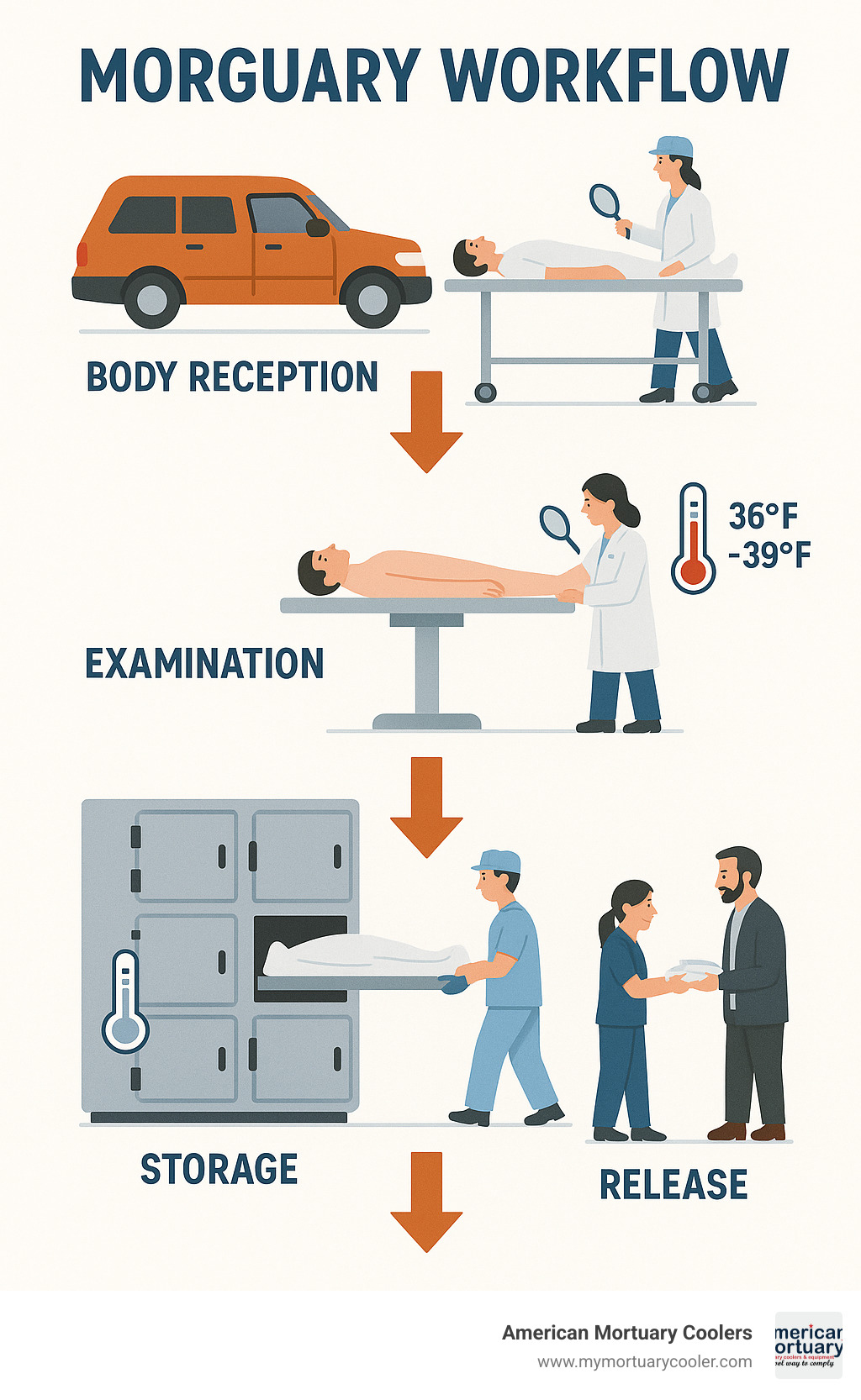
Why This Guide Matters
Understanding the function and operation of a morguary is important for several reasons:
Public Health Role: Morguaries help prevent the spread of disease by properly containing and preserving deceased bodies until final disposition.
Forensic Value: In cases of unexplained or suspicious deaths, the morguary provides a controlled environment for forensic investigations that help determine cause of death and collect evidence.
Grief Support: By preserving remains in a dignified manner, morguaries give families the necessary time to process their grief and make funeral arrangements without rushing.
Educational Purpose: Explaining morguary operations helps reduce misconceptions and fears about what happens after death.
From Paris "Dead Houses" to Today's Cold Rooms: History & Terminology
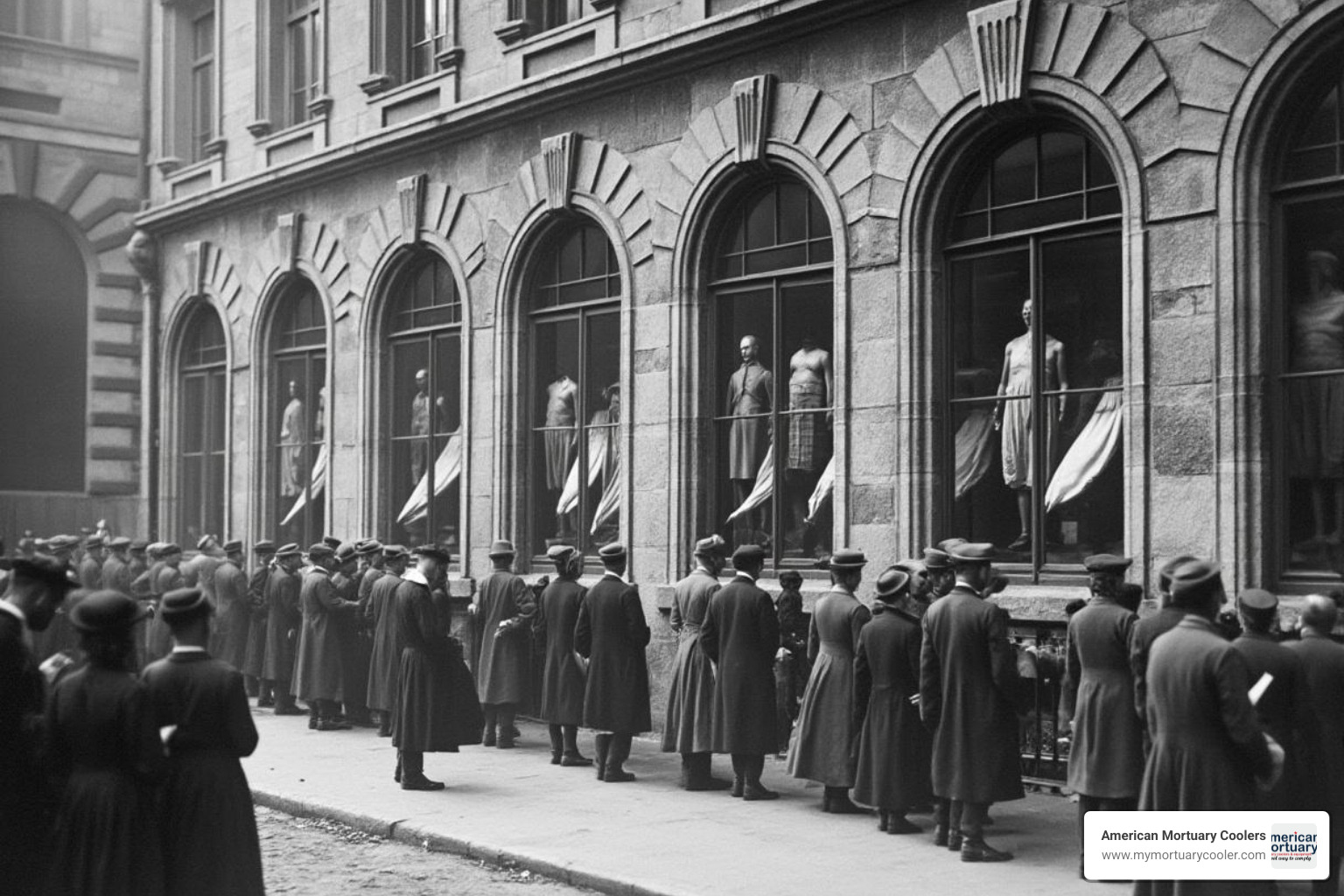
The morguary as we know it today has fascinating origins. The word "morgue" derives from the French "morguer," meaning "to stare." In 19th-century Paris, public morgues displayed unidentified bodies behind glass windows, with thousands of curious visitors daily.
Outside these early morguaries, vendors sold snacks and toys to visitors. While shocking to modern sensibilities, this served a practical purpose before fingerprinting and DNA analysis—helping identify unknown persons through public viewing.
In Scotland, a different approach emerged with "morthouses"—circular stone buildings with rotating wheels that held coffins under lock and key, protecting against bodysnatchers who supplied cadavers to medical schools.
The morguary we recognize today began taking shape in the late 19th century with reliable refrigeration technology, eliminating the need for public viewing and allowing more dignified handling of the deceased.
Key moments in morguary history include:
- 1830s: Scotland's morthouses appear as bodysnatching deterrents
- 1864: Paris opens its glass-windowed morgue for public viewing
- Late 1800s: Early refrigeration technology transforms body preservation
- Early 1900s: Public morgues gradually close as better identification methods develop
- 1950s-1960s: Modern morgue procedures and equipment become standardized
Interested in a deeper historical dive? Check out this fascinating historical look at the Paris morgue.
Morgue, Mortuary, or Morthouse?
These terms often get mixed up in everyday conversation, but they actually refer to distinct facilities with different purposes:
| Term | Primary Function | Typical Location | Historical Context | Temperature Control |
|---|---|---|---|---|
| Morgue | Temporary storage and examination | Hospitals, medical examiner offices | From French "morguer" (to stare) | Refrigerated (36°F-39°F) |
| Mortuary | Preparation for burial/cremation | Funeral homes | From Latin "mortuarius" (of the dead) | Room temperature or refrigerated |
| Morthouse | Anti-bodysnatching security | Churchyards (historical) | Scottish innovation, 1800s | No refrigeration |
A morguary focuses primarily on temporary preservation and examination, with bodies in refrigerated units to slow decomposition while awaiting identification, autopsy, or transfer to funeral homes.
A mortuary is where bodies are prepared for their final farewell, including embalming, dressing, and cosmetic preparation. The historical morthouse served neither preservation nor preparation purposes—it was purely a security measure against cadaver theft.
At American Mortuary Coolers, we design cooling systems for both morguaries and mortuaries, recognizing their different purposes but overlapping refrigeration needs. For more on the specific differences, see our article on Mortuary or Morgue: How to Tell Them Apart.
Inside the Modern Morguary: Types, Procedures, and Technology
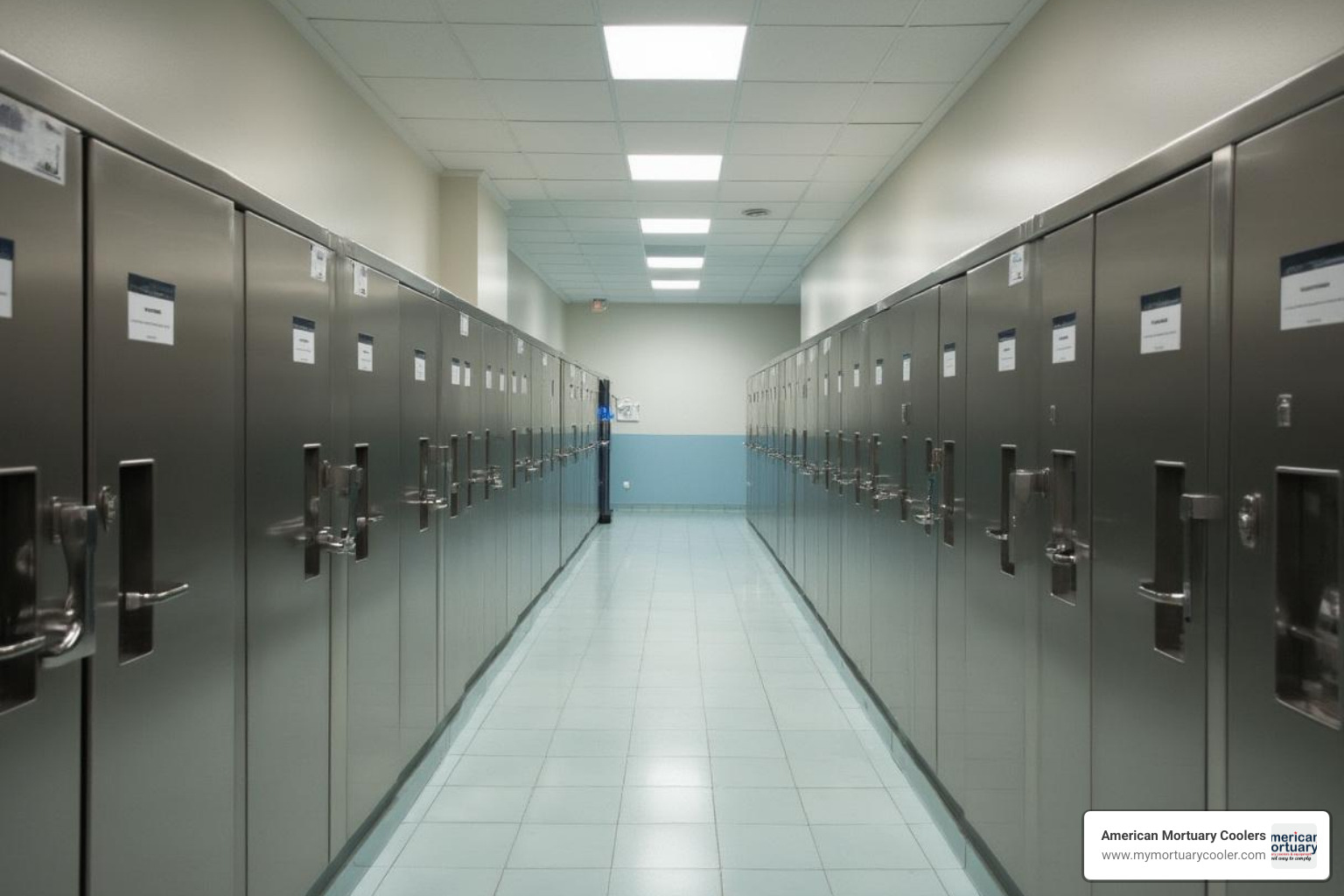
Today's morguary facilities blend clinical precision with compassionate care, employing sophisticated technology that serves essential functions in healthcare, legal, and funeral systems.
Hospital morguaries operate within medical facilities, providing temporary haven for deceased patients. These spaces typically feature modest storage capacity and basic examination capabilities.
Forensic morguaries house tools and expertise for comprehensive post-mortem examinations. Here, medical examiners work to answer questions about how and why someone died, providing closure for families and evidence for legal proceedings.
When disasters claim multiple lives, disaster response morguaries quickly mobilize in convention centers, warehouses, or large tents, handling the necessary work of caring for multiple deceased individuals with dignity.
Many funeral homes also maintain small-scale refrigerated areas that function similarly to morguaries.
At the heart of every morguary is its refrigeration system, maintaining a precise temperature between 36°F and 39°F (2°C-4°C)—slowing decomposition without freezing tissues, which would complicate examination and embalming.
Beyond cooling technology, today's morguaries employ portable X-ray machines, clean rooms for DNA collection, and digital documentation systems with barcode scanners to maintain chain of custody. Many facilities use UV sterilization systems and specialized ventilation to control contamination.
Recent research highlighted in Science Direct morgue studies underscores the importance of contamination control, with one study finding measurable DNA from staff on instruments and surfaces in half of the mortuaries sampled.
Hospital Morguary vs. Forensic Morguary
A hospital morguary typically handles expected outcomes—patients who passed away from natural causes. The admission process is straightforward: a patient is transported from their room, identified with a basic tag, and placed in refrigeration. These facilities typically accommodate just 2-6 bodies, focusing on brief storage until transfer to funeral homes.
In contrast, a forensic morguary deals with deaths that raise questions. Documentation becomes meticulous, recording exactly how, when, and by whom the body was found, transported, and admitted. Each transfer requires signatures, creating an unbroken chain of evidence.
These facilities feature fully equipped autopsy rooms with specialized lighting and recording equipment. Secure evidence lockers safeguard personal effects and samples. Many include family viewing rooms with separate entrances, allowing loved ones privacy during difficult moments.
Disaster-Response Morguary Preparedness
When tragedy strikes on a large scale, standard morguary facilities can quickly become overwhelmed. Disaster-response morguaries follow protocols from organizations like FEMA and INTERPOL, beginning with site selection—finding locations with adequate space, reliable utilities, and accessibility.
Specialized Disaster Mortuary Operational Response Teams (DMORT) mobilize, bringing expertise in handling mass fatalities with efficiency and compassion. These professionals establish a triage system for processing multiple remains while maintaining individual dignity and accurate identification.

At American Mortuary Coolers, we maintain portable refrigeration units ready for rapid deployment across our service regions when communities face these challenging scenarios.
Standard Body Handling Workflow
A standardized workflow ensures dignity, accuracy, and safety throughout the morguary process:
Receipt and documentation: Each person receives a unique identifier with careful documentation of arrival time, condition, and chain of custody.
Initial examination: Noting identifying features, personal effects, and apparent conditions, with photography documenting the body as received.
Refrigeration: Placement in temperature-controlled storage until examination or release.
Examination: Ranging from simple external assessment to complete autopsy, with collection of samples as needed.
Reporting: Detailed documentation of all findings, including determinations about cause and manner of death in forensic settings.
Release: Transfer to a funeral home with appropriate documentation and authorization.
Contamination Control & Biosafety
Modern morguary operations address two distinct risks: DNA cross-contamination that could compromise forensic evidence, and transmission of infectious diseases that could endanger staff.
Many facilities now employ disposable instruments for criminal cases, overnight ultraviolet treatment, and personnel DNA exclusion databases. Thoughtful facility design creates zoned work areas that separate examination spaces, while sophisticated airflow management systems contain potential airborne contaminants.
At American Mortuary Coolers, we design refrigeration units with smooth, non-porous surfaces that resist bacterial growth and facilitate thorough cleaning between uses.
Roles and Responsibilities: Who Keeps the Morgue Running?
Behind every well-run morguary is a dedicated team of professionals who bring unique skills to this essential work.
The Medical Examiner or Forensic Pathologist – physicians with specialized training who determine what caused a death and how it happened. Most have completed not just medical school, but additional years of specialized forensic pathology training.
Morgue Technicians handle everything from assisting with examinations to maintaining equipment and managing the daily flow of receiving, documenting, storing, and releasing bodies. Some come with formal mortuary science education, while others learn through hands-on training.
When identification becomes challenging, a Forensic Odontologist might step in. These specialized dentists can match dental records to remains, providing crucial identification when visual recognition isn't possible.
For cases involving skeletal remains or advanced decomposition, a Forensic Anthropologist brings expertise in examining bones to determine age, sex, height, and identify signs of trauma.
Morticians and Funeral Directors regularly interact with the morguary when transferring loved ones to funeral homes, forming a crucial link between the clinical world and compassionate family support.
In cases involving potential crimes, Law Enforcement Liaisons ensure proper evidence handling and maintain the vital chain of custody.
Administrative Staff manage documentation, coordinate communications, and keep facility operations running smoothly.
In smaller facilities, staff often wear multiple hats, while larger forensic morguaries might have specialists dedicated to each specific function.
Training & Certifications
Medical Examiners and Forensic Pathologists undergo one of the longest training journeys – earning an MD or DO degree, completing a residency in anatomic pathology, followed by a fellowship in forensic pathology, culminating in board certification through the American Board of Pathology.
Morgue Technicians may hold certification from the American Board of Medicolegal Death Investigators (ABMDI) or degrees in mortuary science, plus mandatory OSHA training on handling bloodborne pathogens.
A Forensic Odontologist brings their DDS or DMD degree improved with specialized forensic dentistry training, often with certification through the American Board of Forensic Odontology.
The Forensic Anthropologist typically holds advanced degrees in physical anthropology with specialized training in analyzing human skeletal remains, many with certification through the American Board of Forensic Anthropology.
Beyond specialized credentials, all morguary staff typically receive training in proper use of personal protective equipment, maintaining chain-of-custody for evidence, understanding diverse religious and cultural practices surrounding death, and techniques for psychological resilience.
Safety, Ethics, and Common Myths Surrounding Morguary Work
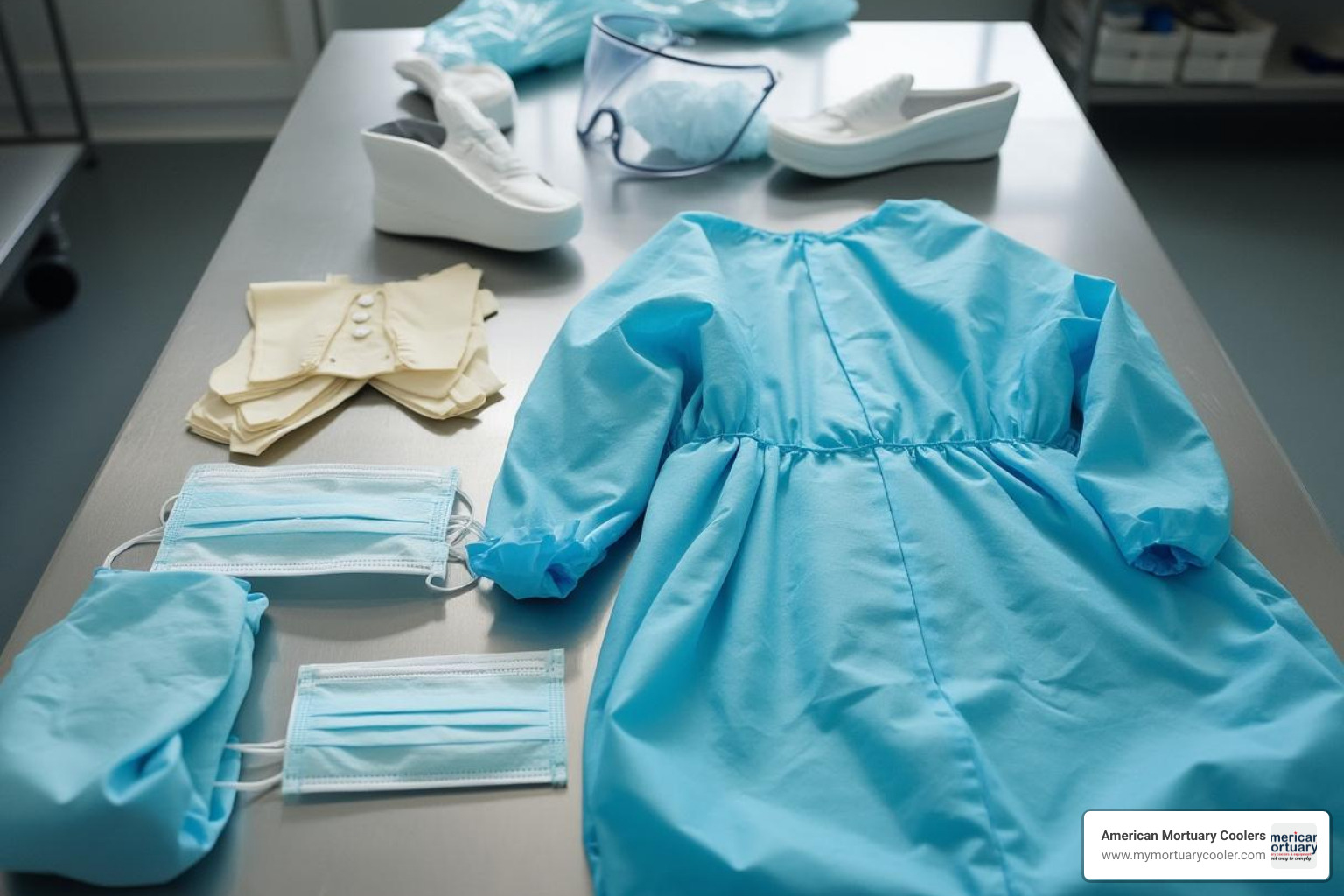
Working with the deceased carries unique challenges. Biological hazards like bloodborne pathogens require rigorous safety protocols. Chemical exposure from formaldehyde and other preservatives must be handled with care. Perhaps most overlooked is the psychological impact of this profession, especially when working with victims of traumatic incidents or children.
"Most people don't realize the emotional weight carried by those who care for the dead," explains a veteran morguary technician. "We see ourselves as the last caregivers for someone's loved one."
Comprehensive safety measures are standard in modern facilities. Personal protective equipment includes full-body coverage, face shields, specialized masks, and multiple layers of gloves. Advanced ventilation systems constantly cycle fresh air, whisking away chemical vapors and minimizing airborne risks.
The ethical framework guiding morguary operations includes:
- Dignity and respect regardless of background or circumstances
- Privacy with strict confidentiality protocols
- Cultural sensitivity to accommodate diverse religious practices
Legal requirements establish clear boundaries through state health codes, OSHA regulations, and privacy laws like HIPAA. In forensic settings, proper chain-of-custody documentation ensures evidence integrity.
Myth-Busting Spotlight
Popular culture has created persistent misconceptions about what really happens in a morguary:
Myth: Morguary coolers freeze bodies. Fact: They maintain a careful temperature between 36°F-39°F—cold enough to slow decomposition but warm enough to preserve tissue integrity. Freezing would damage cells and complicate examination and embalming.
Myth: Every body undergoes autopsy. Fact: Full autopsies are performed on a relatively small percentage of cases—typically those involving suspicious circumstances, unexpected deaths, or legal requirements.
Myth: Unclaimed bodies remain in storage indefinitely. Fact: Most facilities have established protocols for respectful disposition after a specified waiting period, typically ranging from 30 days to several months.
Myth: Celebrities get special handling. Fact: High-profile cases follow the same protocols as anyone else, though facilities may implement additional privacy and security measures.
Myth: Only major cities have morguary facilities. Fact: While comprehensive forensic centers are typically urban-based, most hospitals maintain some form of morguary capacity regardless of location.
Frequently Asked Questions About Morguary Operations
How cold is a morguary cooler?
Standard morguary coolers maintain a carefully balanced temperature between 36°F and 39°F (2°C-4°C). This range slows decomposition processes without freezing tissues, preserving the body while still allowing for proper examination and embalming.
For special circumstances, specialized freezer units below 0°F (-18°C) are used for long-term storage, specific forensic investigations, or remains that have already undergone significant decomposition.
Our standard units come equipped with precise digital temperature control systems, backup power capabilities, and alarm notifications to ensure consistent cooling even during unexpected power outages.
How long can a body stay in the morguary?
The length of time varies by circumstance:
- Routine hospital deaths: 1-3 days until transfer to a funeral home
- Forensic cases: 1-14 days depending on investigation requirements
- Disaster situations: Potentially weeks during identification processes
- Unclaimed bodies: Typically 30-90 days before public disposition
Influencing factors include completion of required examinations, identification status, time for family notification and decision-making, legal holds, funeral home availability, and religious requirements.
Modern refrigeration technology can preserve bodies in good condition for several weeks if necessary, though most facilities aim to minimize storage time for both practical reasons and respect for the deceased and their families.
Do all hospitals have their own morguary?
Not every hospital maintains a full morguary facility:
- Large urban hospitals typically have dedicated morgue facilities with room for multiple bodies
- Medium-sized community hospitals usually have smaller morgue areas with capacity for 2-6 bodies
- Small rural hospitals often have minimal facilities (space for 1-2 bodies) or arrangements with nearby funeral homes
- Specialized facilities like psychiatric hospitals typically don't have morgue capabilities
When a hospital lacks adequate space, they might transfer bodies to a regional medical examiner's office, arrange with local funeral homes for immediate transfer, or use temporary refrigeration units during surge situations.
At American Mortuary Coolers, we provide scalable solutions ranging from single-body refrigeration units for small facilities to walk-in coolers for larger institutions, ensuring dignified care regardless of facility size.
Conclusion & Next Steps
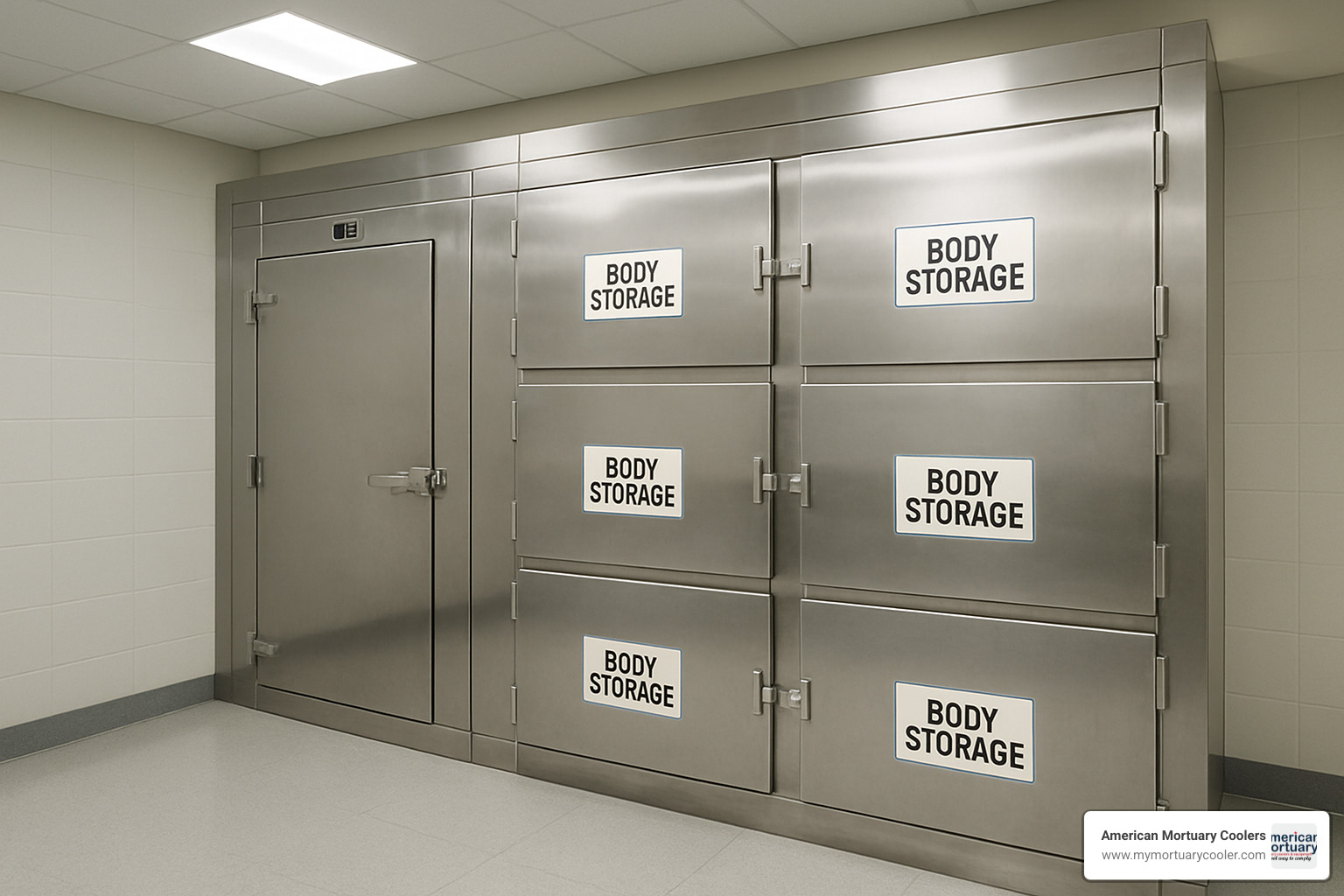
From Paris "dead houses" to today's advanced facilities, the morguary has evolved significantly. This journey reflects not just technological progress, but our growing commitment to treating the deceased with dignity.
Morguaries serve as critical spaces where science meets compassion. They provide families the precious gift of time to process grief and make arrangements. They support our justice system through careful forensic work. And they protect public health through proper handling practices.
The future of morguary technology looks promising. Artificial intelligence is beginning to assist with radiological examinations, potentially reducing the need for invasive procedures. Environmental considerations are shaping more energy-efficient refrigeration systems and greener alternatives to traditional preservation chemicals.
Perhaps most heartening is the trend toward improved family involvement, with modern morguaries creating welcoming spaces for culturally appropriate rituals. Community education efforts are also helping reduce the stigma and mystery surrounding death care.
At American Mortuary Coolers, we're proud to support this essential industry with refrigeration solutions built for the unique needs of morguary operations. Our custom-designed coolers balance technical requirements with the ethical dimensions of death care. We deliver directly throughout the contiguous 48 states from our regional centers in Johnson City, Atlanta, Chicago, Columbia, Dallas, Los Angeles, New York, and Pittsburgh.
Whether you're establishing a new facility, upgrading existing equipment, or responding to emergency needs, we understand the delicate nature of your work. Our team brings both technical expertise and genuine respect for the important service you provide.
We hope this guide has offered valuable insights into the necessary but often misunderstood world of morguary operations. By understanding these facilities better, we can all appreciate the care, professionalism and dignity that goes into this essential aspect of our society's approach to death care.
Ready to explore custom cooling solutions for your facility? Visit your one-stop shop for mortuary coolers to learn more about our custom approach to morguary refrigeration.
